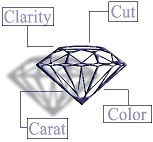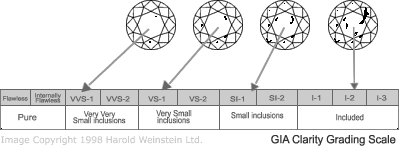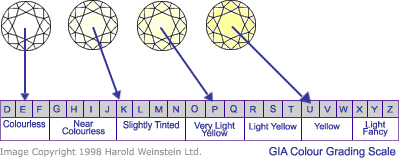Diamond Grading & The 4 C's of Quality
Welcome to the Engagement Ring Styles guide on diamond grading. This guide is designed to educate the average consumer on how a diamondís cost is determined. The retail cost of a diamond is based on the diamondís clarity, color, cut and carat weight. This is commonly known as the 4 Cís of diamond grading and is used worldwide. Its common belief that the clarity is the most important factor in diamond grading, but in reality the cut (primarily) and the color will have a more positive effect on the visual appearance of a diamond. You can start using this diamond grading guide below, each one of the 4 Cís has itís owned dedicated section below.

Diamond Carat Weight
The weight of a diamond is one of the 4 Cís used to put a monetary value on diamond. A carat is a unit of weight that is used to measure the weight of all gemstones. A carat is divided into points, and 1 cart is equal to 100 points. For example, a diamond that is measured at 50 points would be Ĺ a cart or 0.50ct. Prior to 20th century, pod seeds from the carob tree were used to weigh precious gems and this is where the word carat originated from.

Diamond Clarity
The clarity of a diamond is determined by the internal inclusions and blemishes as well as the surface. The internal inclusions are based on the color, size, nature, position and number of inclusions. These internal inclusions are a result of volcanic rock (liquid magna) in which the diamond itself was created in. Diamonds are almost entirely made up of pure carbon. During their crystallization, bits of carbon that formed more quickly as well s other materials can become trapped within the diamond. These types of inclusions can be known as crystals, feathers, clouds, etc. The clarity of a diamond is measured on a sliding scale, starting from best (flawless) to worst (I-3). Clarity is graded by an experienced diamond grader under a microscope using 10x magnification. The final clarity grade is decided by the grader based on how easily they can see any inclusions or blemishes in the diamond.

Diamond Color
The color of a diamond should really be no color at all, like a fresh, clean drop of water. A machine known as a Colorimeter is used for color grading of diamonds, but many vendors believe there is no substitute for a human eye that has been trained for diamond color grading. The grading is usually done by comparing the diamond in question to what is called a master stone.
Diamond color grading is on a sliding scale, starting at D and going all the way to Z. A diamond that is graded D is considered to have no color at all. A diamond that is graded Z is considered a fancy color due to its vivid color. Diamonds that grade under J tend to have a yellowish color tint to them. The best diamond color you could get is a colorless D, E or F grade.

Diamond Cut
A lot of people donít realize how important the diamond cut is to the diamonds actual value. A diamond with the right cut will have an amazing sparkle and maximum brilliance which couldnít be obtained if the diamond was simply cut to meet a certain size ďcaratĒ. For an example of how a diamond cut is graded below is what is used by the Harold Weinstein LTD. Gemological Laboratory. When you look at a diamond it should easily catch your eye and flash within natural and artificial light. If you see a diamond that doesnít do either of those two things you can easily assume it wasnít cut properly, or was simply cut to make it a certain carat size. Remember, a proper diamond cut, along with the right color and clarity is what brings fire to the ice!

